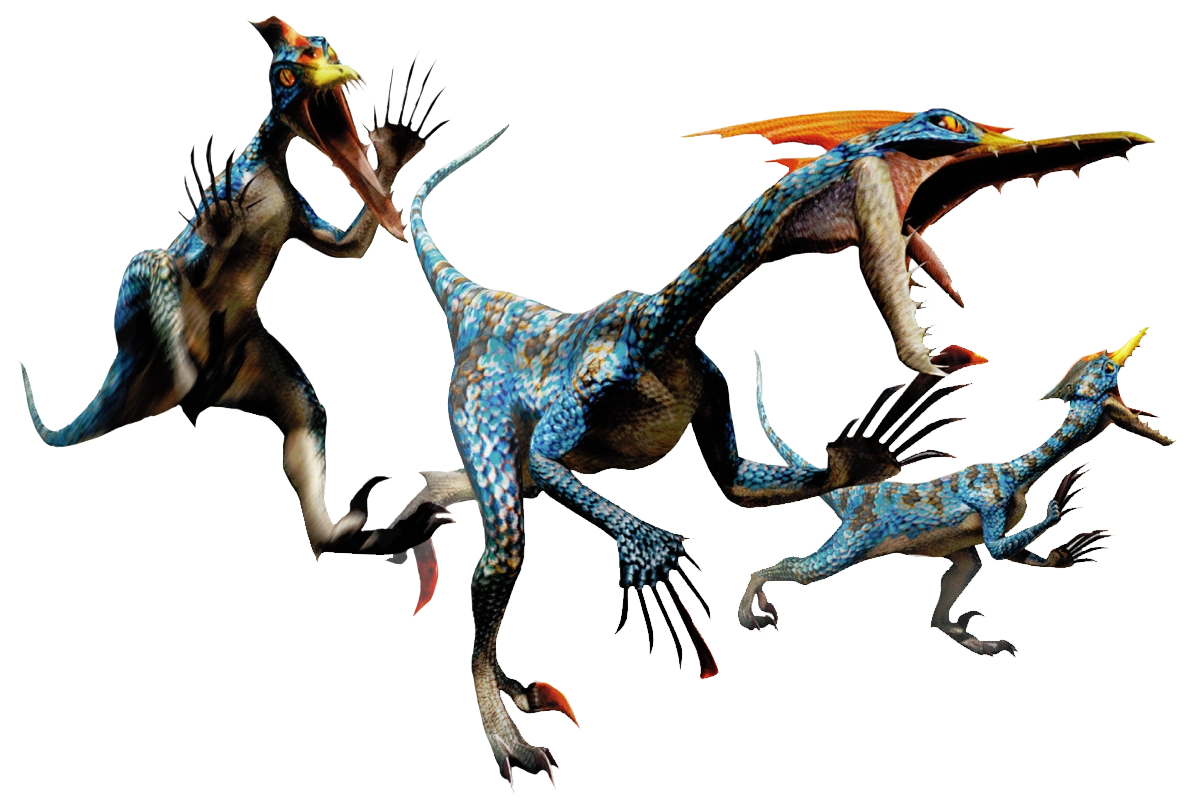
Social pack-hunting Bird Wyverns with blue-scaled bodies covered in black stripes. They have a single backwards-pointing crest on their heads and their beaks are filled with thin, spike-like teeth. Their forelimbs each have seven razor-sharp claws, and each of their hindlimbs bear an enlarged claw on the first digit which is held off the ground.
Mature adults are known as Velocidromes while immature subadults are known as Velociprey. As the alpha leader of the pack, Velocidromes are larger in size and have a more prominent, brighter red crest that shows that they are sexually mature. The middle claws of their forelimbs and their enlarged toe claws are further enlarged and bright red in colour as well. Generally, packs are only led by one dominant Velocidrome, as the other adults are chased away upon reaching maturity to look for another pack to take over. [However during the breeding season], a pair of Velocidromes may lead a single pack together as it improves the hunting strength of the pack and it allows for the pack to split into two groups for hunting.
Typically, Velociprey and Velocidrome packs are found in forested tropical and temperate areas. They mainly prey on small Herbivores such as Kelbi, Mosswine and Aptonoth as well as small Neopterons like Vespoid. Besides that, they often scavenge carrion from the kills of larger wyverns.
Being pack hunters, Velociprey and Velocidrome are relatively intelligent and their highly-developed brains allow them to formulate hunting plans quite quickly. When hunting, they use a range of calls to communicate with each other to cooperate effectively. [Their large yellow eyes likely give them good eyesight.] They normally attempt to surround prey, giving it little chance of escape before pouncing and attacking with their claws. Smaller prey can be killed by a Velocidrome with a single slash of their toe claw. Large packs are capable of bringing down prey larger than young Aptonoth, [in part due to their unique dentition. Their fangs are not adapted for cutting; rather they are adapted for holding onto prey.] Despite looking delicate, they are surprisingly hard to break and it is said that even bombs are unable to shatter them. [They use these teeth to latch on to larger prey while slashing with their claws to kill it.] Occasionally, packs will raid villages when food is scarce.
Velociprey and Velocidrome are quite low in the food chain and can easily end up as prey for larger wyverns, though their speed and agility usually discourages that. Besides acting as warning colours, [their blue scales are actually iridescent. When this iridescence is coupled with their swift movements, it disorients predators and allows them to better evade attacks.] *A Velocidrome spends most of its time patrolling its territory for intruders.* Being heavily set in its pack mentality, it will call for its pack before attacking the threat.
Velociprey and Velocidrome are most closely related to Giaprey and Giadrome, and are also closely related to Genprey and Gendrome as well as Ioprey and Iodrome.
Mature adults are known as Velocidromes while immature subadults are known as Velociprey. As the alpha leader of the pack, Velocidromes are larger in size and have a more prominent, brighter red crest that shows that they are sexually mature. The middle claws of their forelimbs and their enlarged toe claws are further enlarged and bright red in colour as well. Generally, packs are only led by one dominant Velocidrome, as the other adults are chased away upon reaching maturity to look for another pack to take over. [However during the breeding season], a pair of Velocidromes may lead a single pack together as it improves the hunting strength of the pack and it allows for the pack to split into two groups for hunting.
Typically, Velociprey and Velocidrome packs are found in forested tropical and temperate areas. They mainly prey on small Herbivores such as Kelbi, Mosswine and Aptonoth as well as small Neopterons like Vespoid. Besides that, they often scavenge carrion from the kills of larger wyverns.
Being pack hunters, Velociprey and Velocidrome are relatively intelligent and their highly-developed brains allow them to formulate hunting plans quite quickly. When hunting, they use a range of calls to communicate with each other to cooperate effectively. [Their large yellow eyes likely give them good eyesight.] They normally attempt to surround prey, giving it little chance of escape before pouncing and attacking with their claws. Smaller prey can be killed by a Velocidrome with a single slash of their toe claw. Large packs are capable of bringing down prey larger than young Aptonoth, [in part due to their unique dentition. Their fangs are not adapted for cutting; rather they are adapted for holding onto prey.] Despite looking delicate, they are surprisingly hard to break and it is said that even bombs are unable to shatter them. [They use these teeth to latch on to larger prey while slashing with their claws to kill it.] Occasionally, packs will raid villages when food is scarce.
Velociprey and Velocidrome are quite low in the food chain and can easily end up as prey for larger wyverns, though their speed and agility usually discourages that. Besides acting as warning colours, [their blue scales are actually iridescent. When this iridescence is coupled with their swift movements, it disorients predators and allows them to better evade attacks.] *A Velocidrome spends most of its time patrolling its territory for intruders.* Being heavily set in its pack mentality, it will call for its pack before attacking the threat.
Velociprey and Velocidrome are most closely related to Giaprey and Giadrome, and are also closely related to Genprey and Gendrome as well as Ioprey and Iodrome.
No comments:
Post a Comment